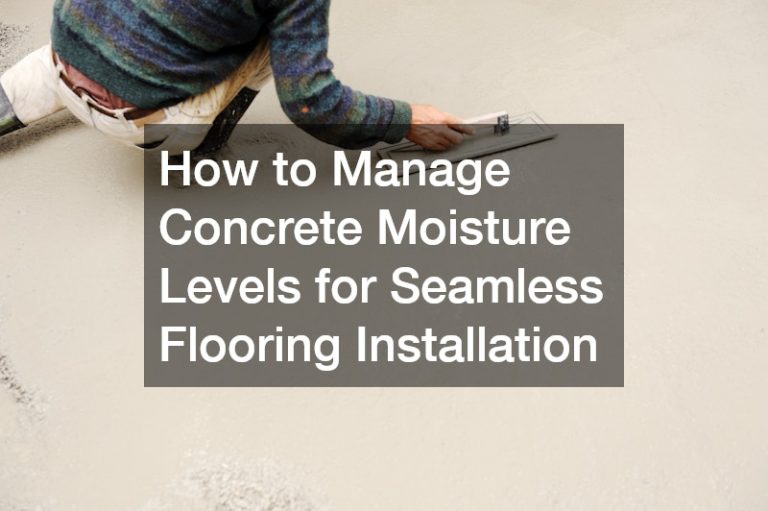When installing flooring systems, ensuring the concrete slab is adequately prepared and moisture-free is crucial. Excess moisture in concrete can lead to flooring failures, mold growth, and costly repairs. To achieve perfect flooring installation, it’s essential to follow a systematic approach to measuring and managing concrete moisture. Here are some essential tips to help you manage concrete moisture for flawless flooring installation.
1. Understand the Flooring System Requirements
The first step in preparing for flooring installation is to understand the specific requirements of your chosen flooring system. Different flooring materials have varying tolerance levels for moisture, and the flooring system you choose should be designed for use with concrete substrates.
2. Choose the Right Adhesives and Moisture Levels
Using the correct adhesives is vital to secure the flooring material to the concrete slab effectively. Adhesives have specific moisture tolerance levels, and using the wrong adhesive can result in bond failure. Before installation, verify that the moisture level in the concrete is within the acceptable range for both the adhesive and the flooring material. This step prevents future issues and ensures the longevity of your flooring.
3. Implement the Installation Quick Check
Even if pre-installation moisture testing has been conducted, conditions may change, impacting the installation. Implementing a quick moisture check before installation can prevent potential failures. Utilize a reliable concrete moisture meter to assess the current moisture levels in the slab. This proactive measure helps identify any unexpected moisture issues that could compromise the installation.
4. Measure Ambient Conditions and Dew Point
Accurately measuring the ambient conditions and dew point is critical in determining the suitability of the concrete for flooring installation. Use a hygrometer to record the ambient conditions, including temperature and humidity. Focus on the dew point, which indicates the temperature at which moisture in the air will condense. For optimal results, the slab’s surface temperature should be at least 10 degrees Fahrenheit above the dew point. This temperature differential helps prevent condensation on the slab, which can lead to moisture-related problems.
5. Perform Surface Temperature Scans
Before proceeding with installation, scan the surface temperature of the concrete slab. The surface temperature should be measured using a reliable infrared thermometer. If the surface temperature is well above the dew point, the risk of condensation is minimized, creating a dry and stable substrate for flooring.
6. Conduct Thorough Surface Moisture Readings
To obtain accurate moisture content readings, you should conduct thorough surface moisture tests. Clean the surface of the concrete slab to remove any residue, paint, or drywall mud that could interfere with the readings. Using a concrete moisture meter, take multiple readings across different points on the slab. To identify any moisture hotspots, follow the “around the horn” method by measuring at 12 o’clock, 3 o’clock, 6 o’clock, and 9 o’clock positions.
7. Adhere to Industry Standards for Moisture Content
Industry standards, such as those set by ASTM (American Society for Testing and Materials), recommend specific moisture content levels for different flooring applications. For floor coverings, a moisture content of 4 percent is generally acceptable. For concrete coatings, the threshold is often set at 3.5 percent. Adhering to these standards ensures that the concrete is sufficiently dry for the chosen flooring system. Additionally, standards like ASTM F3010 provide guidance on moisture vapor emission rates. Take at least eight readings in the first 1,000 square feet and five readings for each additional 1,000 square feet to achieve accurate and reliable results.
8. Protect Yourself Against Moisture-Related Claims
If no pre-installation moisture testing was conducted and the flooring or coating fails due to moisture, the responsibility often falls on the installer. To protect yourself from potential claims, always conduct thorough moisture testing before installation. Document the readings and make sure they meet industry standards. This proactive approach safeguards your reputation and minimizes the risk of costly disputes.
9. Ensure Proper Drying and Seek Professional Advice
If the moisture content in the concrete slab exceeds the acceptable levels, take the necessary steps to dry the slab before proceeding with the installation. Use dehumidifiers, fans, and other drying techniques to reduce moisture levels. If the moisture issues persist, seek professional advice to ensure the slab is adequately prepared for flooring installation. Professional intervention can provide specialized solutions and prevent future problems.
By following these essential tips, you can manage concrete moisture levels and achieve perfect flooring installation. Ensuring the concrete slab is dry and suitable for the chosen flooring system is the key to a durable and successful installation. Take the time to perform thorough testing and adhere to industry standards to protect your investment and achieve flawless results.
.


